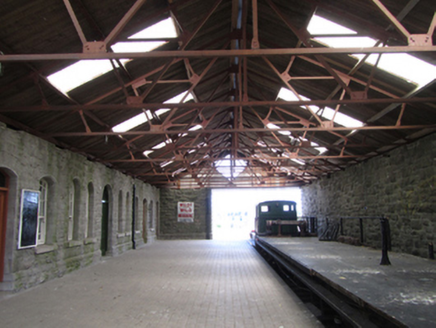Survey Data
Reg No
40307025
Rating
Regional
Categories of Special Interest
Architectural, Historical, Social
Original Use
Railway station
In Use As
Heritage centre/interpretative centre
Date
1885 - 1890
Coordinates
236533, 316649
Date Recorded
19/06/2012
Date Updated
--/--/--
Description
Attached nine-bay single-storey former railway station, built 1887, with gabled breakfront and projecting canopy, roofed platform and track to rear. Now in use as visitor's centre. Hipped slate roof, overhanging eaves with fascia and barge boards. Clay roll-moulded ridge tiles with three stone chimney stacks having string course and tapered capping, cast-iron rainwater goods. Timber canopy to entrance resting on decorative curved cast-iron wall brackets, timber sheeting to sides with serrated fringe. Snecked random coursed rock-faced ashlar limestone walls over, projecting plinth. Segmental-headed window openings and paired round-headed windows in breakfront flanking entrance, all with smooth dressed chamfered arrises and reveals, stone sills and historic timber sash windows with margin panes. Round-headed door opening with double-leaf timber panelled doors with fanlight. Entrance hall with cast-iron fireplace to west end, plaster cornice and surrounds to openings, rendered walls and recent timber floor. Platform elevation as entrance elevation. Corrugated-iron roof on steel truss roof resting on station platform elevation and squared-random rock-faced stone wall opposite. End gables of platform roof with vertical timber sheeting with serrated fringe. Platform floor of recent concrete paving slabs.
Appraisal
Belturbet Railway Station was built by the Great Northern Railway Company to link with the Great Northern Railway broad gauge. It also linked with the Cavan and Leitrim Railway narrow gauge railway line which served the coal mine at Arigna. Along with the station, the surving buildings includes the adjoining station master’s house, engine shed and goods shed. Designed by W.H. Mills, it is built in the GNR signature round-arched style, and the quality and craftsmanship are typical of the great railway expansion in the nineteenth century. Retaining many historic features, it is a reminder of the extent of the rail network in the past, which brought about significant social and economic.















